Sitting on a Hawaiian island in the middle of the Pacific Ocean, looking at the Milky Way clearly stretch out across the sky with the naked eye is an incredible, awe inspiring and humbling experience. But getting an image of it certainly proved tricky, despite having a D3s. ISO 102,000 certainly came in handy though at times! I finally managed to get this image however, with the foreground waves crashing on the shoreline rocks and the distant islands of Kahoolawe, Molokini + light house and Lanai just visible in the distance was incredible.
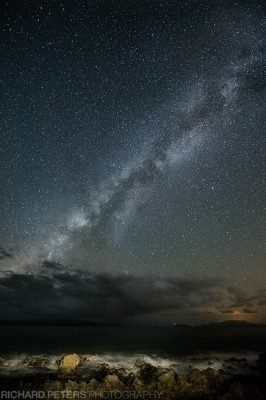
Milky Way over Maui
Main Image info
Camera: Nikon D3
Lens: 14-24 f2.8 (review coming soon)
Settings: 14mm, f2.8, 30 seconds at ISO 6400
Accessories: Gitzo GT5541 LS tripod, Really Right Stuff BH-55 ballhead
EDIT: As a follow up to this article, Nikon Europe asked me to write a Top Five tips to shooting the Milk Way following my experiences, for their Official Nikon Europe Blog. You can read that article here.
If you live somewhere on the planet that allows you to see it on a regular basis, I envy you. In the UK it’s almost impossible to see it anywhere but a very few limited, isolated places. Photographing it was at the top of my ‘to do’ list on my trip to the Hawaiian island of Maui. However, I think I was a bit blasé about how tricky it would prove to be. I knew some of the clearest and best views on earth of the night sky could be found here, especially at the 10,000 foot summit of the Haleakala Volcano (the world’s largest dormant one). I had a D3s for the week, which of course is second to none in high ISO performance. And, I even had a loaner Nikon 14-24 from the great folk over at B&H Photo (review coming soon). So, there was me thinking it’d be easy. I’d just get to Maui and have my pick of where to get fantastic night sky photos. And in fact, on our arrival the first night, there it was, the Milky Way looking down at me between some clouds. I took a quick grab shot, which I posted on a couple of forums and smugly went to bed thinking I was going to get more photos than I knew what to do with…how wrong I was! But let me say this, chasing our galaxy around the sky all week was not only frustrating and challenging but also fantastic fun.
Light, or lack thereof
First of all, to get a good shot of the sky you need little light pollution. And Maui gives you that in abundance. In fact, away from small pockets of street lights in the towns there are no lights at night. Not on the highways, not on residential streets, nowhere. And when you are somewhere with no light sources at night, including the moon, it’s actually slightly surreal just how dark it is. We would literally pull up at the side of the road, get out the car and have no idea what was 5 foot in front of us. I could hear the ocean, I could hear the rustle of trees, but I had no idea exactly what the view in front of me was like. But, that’s also where the legendary high iso of the D3s came in helpful. I found myself taking 2 or 3 second hand held exposures at ISO 102,400 just to get a quick idea of what view looked like off in the distance. How insane is that! That I could take quick photos with a camera in areas that were so dark, I couldn’t see anything, yet the camera was able to give me a rough idea of what was around. Just for fun, I’ve posted one here. It’s safe to say the Nikon D3s really can see in the dark. ISO 102,400, hand held. Insane!
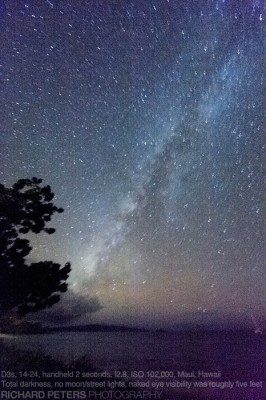
Nikon D3s, ISO 102,400 hand held for 2 seconds!
Using this technique allowed me to quickly compose the camera to get shots. The image above shows you how I was able to get an idea of what the view was in the horizon, without having to set up the tripod first and take 30 second exposures.
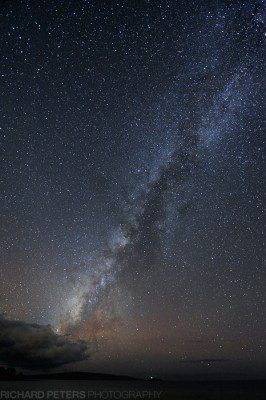
Milky Way, D3s, 30 seconds, ISO 5000
Cloud cloud and more cloud
So I had my pollution free skies, but that wasn’t enough as I also needed clear skies, and that was something I had just assumed I would get. But unfortunately my biggest obstacle during my time on Maui was cloud the cover. You see, it doesn’t matter how dark it is, how much you’ve pre-planned or how good your equipment. If mother nature has other plans, you’re up a certain creek without a paddle – and I seemed to spend an awful lot of time up that very creek!
Haleakala Volcano
This was where I mainly wanted to get Milky Way shots. The night sky viewed at the 10,000 foot summit is supposed to be spectacular, because of course there is less atmosphere between you and the stars. There is even an observatory up there, so I figured if it’s good enough for one of those, it’s good enough for me! On two occasions we drove to the summit, which incidentally is the shortest distance in the world that you can drive to that altitude, as the road is only 35 miles long. The first time we did the drive was late afternoon to wait for it to get dark, but that went wrong because the clear day turned in to a cloudy night as the sun went down. And the second time, there was even more cloud cover so we headed down to 4,000 feet to wait for sunset. Then, as the night rolled in the sky started to slowly clear, I could already see at 4,000 feet that the sky looked more vibrant than I had ever seen before and the Milky Way was incredibly clear with the naked eye as it peered out between gaps in the cloud. So, excitedly we drove the remaining 6,000 feet to the top again, even though the fuel light had come on in the car, only for the cloud cover to have rolled back in before we got there. See. I really did put the effort in and find myself playing cat and mouse the whole time trying to get those cloudless skies.
I don’t mind telling you, I was getting very frustrated during the week we spent on Maui. Photographers everywhere know what it’s like to get frustrated when you are trying to get ‘the’ shot and are unable to do so. But to be half way round the world, in the ideal location for your subject, with some of the best kit to get the image, and still not be able to do so, with time rapidly running out is disheartening to say the least. Nope, I was not happy and with every passing cloudy day my enthusiams was wearing thinner and thinner!
Bitter sweet final night
Fortune was thankfully on my side on our last night, but it was bitter sweet because although I finally got the clearest sky yet, earlier that day I had to return the rental D3s (thanks to everyone at Hawaii Camera for the rental)! That’s not to say I was in a bad position ‘only’ having my D3 on the final night but once you’ve seen the clean ISO’s of the D3s it was very frustrating to at last get the right conditions, but not have that little ‘s’ on the front of the camera when capturing it. But, I’ve always said that within reason a noisy shot is better than no shot and that’s something I’ll always stand by. The D3s though, produced much more pleasing images at just ISO 5000. Compare the bottom of the frame of the D3s image above, and the D3 image below and you’ll see just how much cleaner the D3s is in the dark areas. And added to that, I had to work on the D3 image to get it to that level whereas the D3s image is almost as shot!
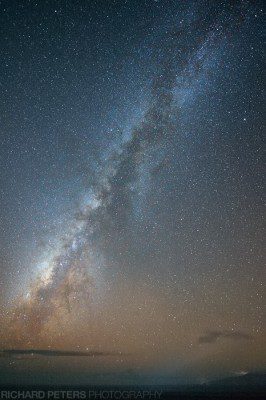
Milky Way, with the island of Lanai bottom right
A clear patch of sky
The final night was, without a doubt, the very best view I got of the Milky Way during the entire trip. There was a huge expanse of clear sky and you could fully see the arc of our galaxy as it spread from the horizon, right over my head and over the top of the mountain behind me. Incredible. But the shot wasn’t quite right. Whilst it was a good view of the sky, I wanted some foreground interest, and with the knowledge that cloud cover could return quickly, I decided my best bet was to head for a location I had found before, close to the shoreline on an area of the island near where we were staying, in Kehei.
So we raced back to that location, but, as you can see from the image at the top of this post, there was already some cloud off in the distance rolling in! The Milky Way though, was for the most part clear and free from obstruction so I managed to get what is for me, a much more interesting shot than the others posted above. Including those foreground rocks with waves crashing off them really adds a nice extra element to the image that helps anchor the sky down. I’d have loved to drive back to the top of the Haleakala Volcano that night, but that was almost a 3 hour drive and so I had to get the shot there and then before that distant cloud got closer.
Would I have preferred more opportunities and images to pick from and show you? yes of course – but that’s just the photographer in me. We all want to improve our shots and do better than we did. But, I’m just grateful that I got a couple of shots as I could just have easily could have come away with no photos of this wonder of nature. And I’m so glad I had the 14-24. It’s not often you can say 14mm on a full frame camera isn’t wide enough, so my 28-70 would have been useless as even 14mm felt restrictive when trying to get the Milky Way in the frame! But, despite all the ups and downs and missed opportunities, I loved every single minute of attempting to get the shot. And that’s half the fun of photography for me, and it’s those times when it all comes together briefly that make the capture of the image feel al the more rewarding.
As I said earlier, seeing this amazing sight really is incredible. It’s just a shame that such a spectacular view isn’t possible for so many people around the world due to modern day light pollution. To think once upon a time you would have been able to look up at night and seen the wonder of our galaxy spreading across the sky from anywhere in the world…
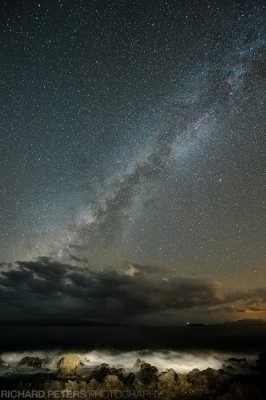
Milky Way over Maui








